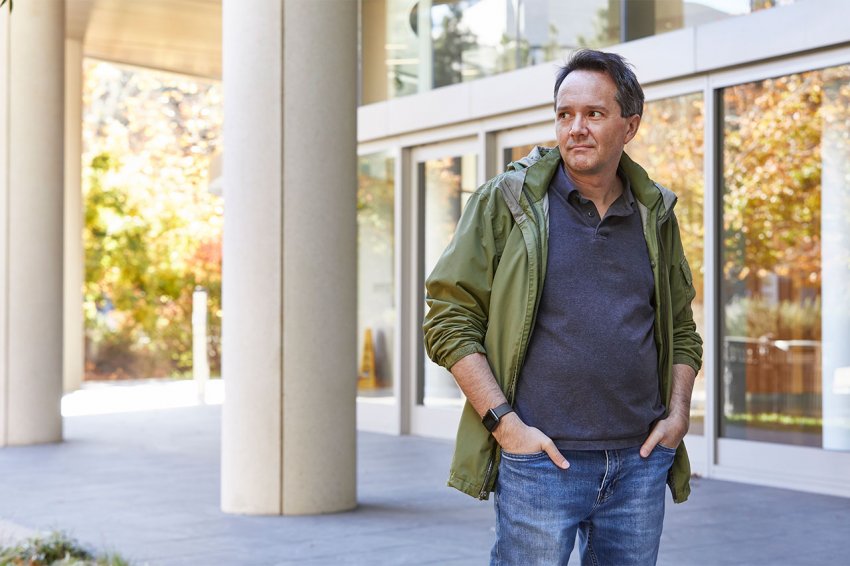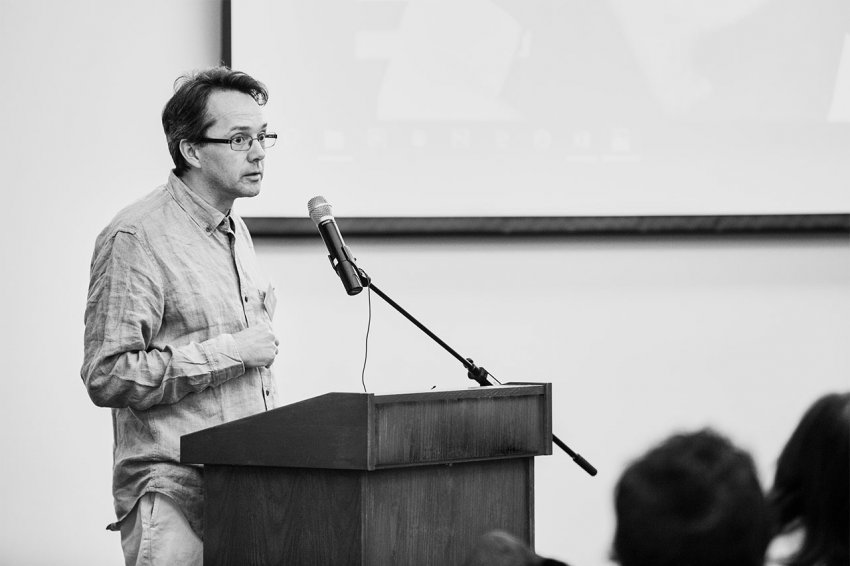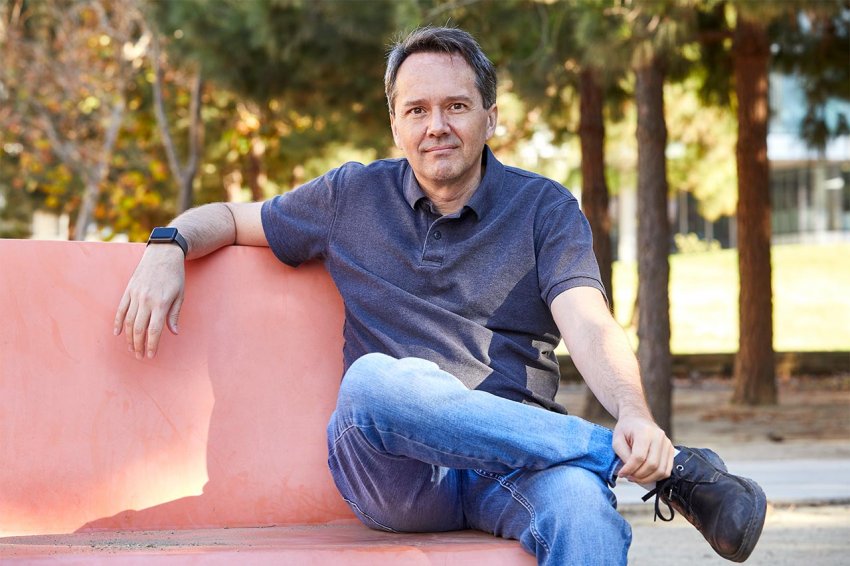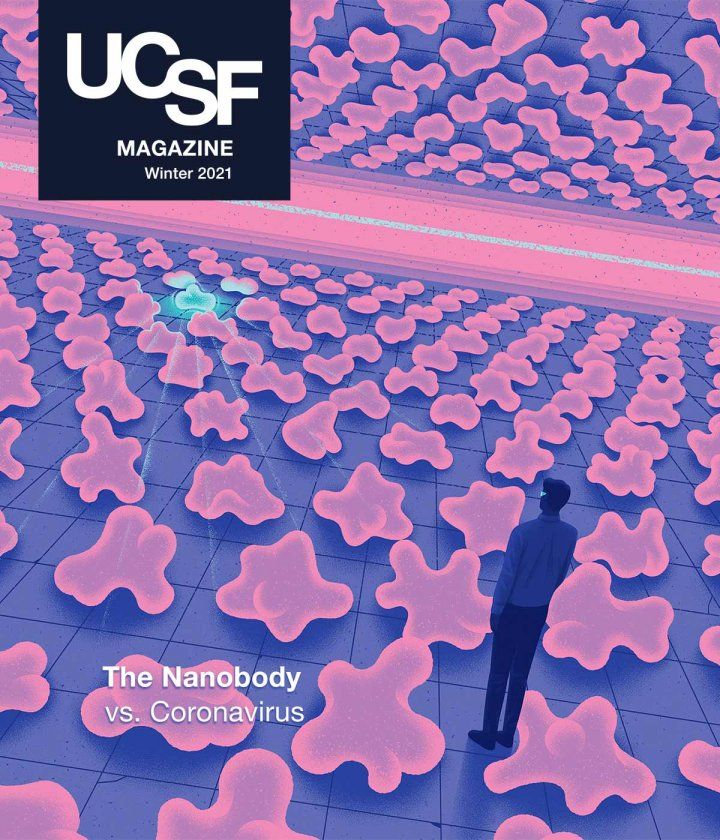It was 30 minutes after his wife had turned in for the night, and Matthew Jacobson, PhD, sat alone as he prepared to swallow a drug capable of delivering a diagnosis he had avoided for years. No longer could he ignore his worsening symptoms – tremors, an unsteady gait, severe pain shooting down his arm. The time to leave the comforting arms of denial had arrived.
Lying in his palm was a small capsule containing levodopa, commonly known as L-dopa, a medication that can both diagnose Parkinson’s disease and treat the disabling neurodegenerative disorder that, by all rights, the 39-year-old UCSF chemist was too young to have.
The journey to this moment on July 23, 2012, had been a long one. And Matt Jacobson had fought it every inch of the way.
In the prime of his life, the lanky, boyish-looking scientist was then 10 years into his career at UCSF, where he had arrived in 2002 after sojourns at four of the world’s great universities. Head of his own lab in the School of Pharmacy and a rising star in the field of computational biophysics, he was then toying with the idea of launching the first of five drug discovery start-ups in his future.
It’s a story Jacobson is practiced at telling. He shares his saga every November with his students, to ensure that the future pharmacists grasp the science, the treatment nuances, and the human being behind every prescription. This past fall, he’s once again telling the tale to a virtual classroom of 100 or so rapt second-year pharmacy students. At this moment in his lecture, Jacobson always pauses to ask whether there are any questions. The students shake their heads.
So Jacobson, dressed casually in jeans and a T-shirt and with a plaid jacket tied around his waist, plows on. If he is tired (and chances are good that he is), he doesn’t show it. It’s obvious in the way he taught before the pandemic – when he stopped to scan the auditorium for quizzical looks, bounded up the stairs to check whether a worksheet was correct, stayed late to discuss a relative’s symptoms – that the classroom and the students in it are extremely important to him.
Returning to his story, he says the first clue may have been a loss in his sense of smell when he was in his late teens. Curiously, he could detect malodorous odors, but not certain pleasant ones. During his college years, he battled both exhaustion and depression – also symptoms of Parkinson’s – but chalked them up to stress fueled by his aggressive academic goals.
While Jacobson was still an undergrad, his Stanford chemistry professor, renowned scientist Richard Zare, PhD, tapped him to co-author a textbook about laser experiments. After graduating Phi Beta Kappa from Stanford, he earned his PhD in physical chemistry from the Massachusetts Institute of Technology, then spent the next several years at Oxford and Columbia doing postdoctoral work in computational biology. Along the way, Jacobson taught classes in macromolecular simulations, structural biology, and computer-aided drug design. Explaining why he was so tired was easy.
It’s very profound when your body is doing something and you don’t have control. It was my first hint that something was really wrong.”
He couldn’t, however, explain his physical ailments. And they worsened. After a late night in 2009, preparing a lecture he was to give at a conference, he spilled his coffee all over the floor. “My hand started trembling, and I realized I couldn’t stop it,” he recalls. “It’s very profound when your body is doing something and you don’t have control. It was my first hint that something was really wrong.”
While he fought his tiredness with caffeine (and blamed his tremors on too much caffeine), he couldn’t ignore the pain radiating across his back, along his right arm, and into his little finger. “Pain really sucks,” he says. Finally, he underwent a thorough check-up at UCSF’s spine center. Three doctors declared that whatever was wrong had nothing to do with his spine and told him: We can’t explain your symptoms.
“When you have high-powered, world-class clinicians, with a look of concern in their eyes, saying, ‘You should go see a neurologist,’ you know it isn’t good,” Jacobson recalls.
He ignored them.
For the next three years, Jacobson struggled. His wife and son kept asking him to stop mumbling, he sometimes appeared drunk, he occasionally fumbled with his fork, and his right hand could no longer control his computer mouse. Finally, even denial failed him.
In the early summer of 2012, Jacobson consulted a neurologist, who put him through a battery of tests that included a finger-tapping drill, a peek at the soles of his shoes, and a balance exercise in which the doctor stood behind him and pulled him backward to see if he fell. “That’s literally the test,” Jacobson says, disbelievingly.
As he left the office, the neurologist uttered words that are still seared into his brain: “I don’t want you leaving here today thinking you have some awful neurodegenerative disease. It might just be Parkinson’s.”
“When that’s the message,” Jacobson states matter-of-factly, “you know you’re screwed.”
To be fair, he says, he knew what the doctor meant. For someone his age, with his symptoms, the fear was that he might have amyotrophic lateral sclerosis – or ALS, also known as Lou Gehrig’s disease – a cruel disorder that kills with alarming swiftness. Parkinson’s, however, is no walk in the park. And Jacobson was thriving professionally. He had climbed the ranks to full professorship and was earning accolades as both a career scientist and an educator. His wife, Judy Chu, EdD, had a rewarding job, teaching social science at Stanford, and their son, Alexander, was only 8. But, he notes, the day of reckoning could be put off no longer.
As Jacobson recites his journal entry from July 23, 2012, to his class, he admits the poignancy of his now-familiar words. He carefully swallowed half a tablet of L-dopa and within 15 minutes could feel the drug starting to work. His right arm, which had felt numb for a very long time, began to wake up.
When a faculty member asked how I was doing, I was almost chipper: ‘I have Parkinson’s!’ I exclaimed.”
For pharmacy students laboring to understand the effects of drugs, Jacobson offers a firsthand account as well as the observations of a trained scientist. His body’s quick response confirmed his fear: He had young-onset Parkinson’s, which had likely been developing for years. “I started to feel normal, and I hadn’t felt normal in a very long time,” he reads from his journal.
When your brain has been deprived of dopamine, he explains, receiving L-dopa is akin to a “rush.” “Almost immediately,” he wrote, “I had an increase in my arm swing on my right side. I was walking faster, talking faster, eating faster, and I definitely noticed an improvement in my mood. When a faculty member asked how I was doing, I was almost chipper: ‘I have Parkinson’s!’ I exclaimed.”

Most patients with Parkinson’s are older than 50 when they are diagnosed, a fact that Matt Jacobson found hard to square with his 39-year-old self. Photo: Gabriela Hasbun
The Day After
First he told Judy, then Alexander, whose sole question was: “Are you going to die?” After being reassured that his dad was not – at least not any time soon – the child relaxed. But the complete answer to his question is more complicated. Most websites devoted to the disease say patients die with Parkinson’s, not from Parkinson’s. But Jacobson says that message, while well-meaning, isn’t quite true.
“Mortality rates among Parkinson’s patients increase dramatically,” he says, “and if that’s the case, then people are dying from Parkinson’s. My life expectancy went from 85 to about 67.” Still, hearing he had another 25 years or so to live was reassuring, and Jacobson decided to be open about his diagnosis to avoid trying to hide his symptoms or puzzled looks from colleagues.
One of his first steps was to acquaint himself with the experience of actor Michael J. Fox, the poster patient for Parkinson’s disease, who was diagnosed in his early 30s. Fox expressed a sentiment in his memoir Lucky Man that resonated with Jacobson. Fox’s advice, as Jacobson recalls it, was: “Those of us with young-onset Parkinson’s have a unique responsibility in communicating to the public about the disease. In part because we illustrate that it is a disease. It’s not just getting old. We’re also at the heights of our careers, and you can have an impact in a way that is harder when you’re retired or elderly.”
Jacobson soon realized that he had an audience few others could claim: UCSF classrooms full of aspiring pharmacists. So, two years after he was diagnosed, he began teaching about treatments for Parkinson’s and other neurodegenerative diseases. Happily, he has found the class hugely rewarding, calling it “about as satisfying as teaching gets, because I can teach more than science.”
To prepare, he plunged into an exploration of the disease that was slowly but surely claiming his life. As a patient, and certainly as a scientist, Jacobson notes, it’s human to want to know why you got sick. While research reveals that Parkinson’s is caused by the degeneration of dopamine-producing neurons – known as the feel-good transmitters – what causes that decline is unknown for most patients. No biomarkers, or telltale signs, exist to diagnose Parkinson’s, a disorder first described in 1817 by British surgeon and apothecary James Parkinson.
There is one commonality among most patients, however: 90% are older than 50 when they’re diagnosed, a fact that Jacobson found hard to square with his 30-something self. But, he notes, it makes the point that the tremors experienced by many sufferers – often dismissed as “old age” – are caused by an eminently treatable disease.
Such an observation emphasizes the disquieting fact that Parkinson’s is underdiagnosed among the aging, due to the dearth of specialists trained to spot the disorder. It afflicts more than 1 million Americans, and about 60,000 new cases are diagnosed every year. Advocating for these patients is one reason Jacobson teaches the class. “This is critical: Parkinson’s is a disease that can be treated. And when treated properly, we can participate more fully in life.”
That’s the case as long as patients receive adequate amounts of L-dopa, which Jacobson calls a “nearly perfect drug” because it replaces what the patient has lost – dopamine. It has a significant drawback, however – a terrifically short half-life. Once ingested, the drug stays in the body only a few hours.
“For those of us living with Parkinson’s, this affects our day-to-day life more than anything,” he tells his class. “The change can happen over a time scale of 15 to 30 minutes. You look normal and then, bam, the drugs are gone. Either you risk dyskinesia [uncontrolled, involuntary movements], which is a side effect of L-dopa, or you risk tremors, which return once the drug wears off.
“So, basically you can have uncontrolled movement at any point in the day, except when you’re sleeping, thank goodness,” he tells the class. “This is the challenge of treating this disease.”
Early in his diagnosis, Jacobson attended a Parkinson’s conference, where he was struck by how poorly medicated most of the 500 participants appeared, many of whom exhibited the jerky, spasmodic motions characteristic of undermedicated Parkinson’s. What he saw emphasized the huge impact pharmacists can make.

For pharmacy students struggling to understand the effects of drugs, Jacobson offers a personal account, as well as the observations of a trained scientist. Photo: Elisabeth Fall
Sharon Youmans, PharmD, MPH, vice dean of UCSF’s School of Pharmacy, agrees. “It's an example of why we are here at UCSF,” she says. “He’s telling his students: ‘This is what I experience. This is what the side effects are. These are the challenges I have in taking these medications.’ The information sticks because now you have a face attached to it. It’s an experience the students will never, ever forget.
“I’ve never asked him, ‘Why do you do this?’” she adds. “I’m just grateful that he does.”
Pamela England, PhD, a colleague of Jacobson’s with whom he is working to develop treatments for neurodegenerative disorders, calls the class a one-of-a-kind opportunity. “Not only does Matt provide a firsthand account of a patient, but it’s the firsthand account of a patient who’s also a scientist. He gives students real insight into how the drugs actually work and should be used – critical information for a pharmacy student.”
Jacobson hammers this lesson home with the class: How much L-dopa should he take? How often? Does it matter whether the patient is male or female? Is weight a factor? What about a person’s own biochemistry? He currently takes the drug every 75 minutes; his phone alerts him when it’s time for another dose. The level is considered extreme (his initial dosage was just three times a day) and explains why he never leaves home without it.
Another treatment suggested by Jacobson’s neurologist is deep brain stimulation – performed by drilling holes into a patient’s brain to insert electrodes. While the procedure has been successful in restoring patients’ control over physical movements, patients risk damage to their cognitive abilities.
“Every time I see my neurologist,” Jacobson says, “he asks: ‘Have you thought about doing this?’ ‘No,’ I say.” Later, Jacobson explains, “To me, the risk is a very poor tradeoff. I can live with the motor symptoms, but my brain’s got to be able to operate at a high level. My entire job revolves around using my brain. It’s the only thing I’ve got.”

Jacobson has an impressive track record starting drug companies. His latest is focused on drugs designed to treat neurodegeneration. Photo: Gabriela Hasbun
The Inflection Point
Jacobson spent his youth and early adulthood building an educational pedigree and launching his career in computational biophysics. Professionally, he has hit all the high marks: In 2015, he was named chair of the Department of Pharmaceutical Chemistry – a post he held until the end of 2020 – and in 2016 he was appointed to the Thomas and Frederick MacWilliam Distinguished Professorship. His diagnosis clearly did not derail his career, but it did refocus his path.
While he has stepped away from some academic duties partly due to the exhaustion of living with Parkinson’s, he is determined to continue teaching. Not only because it is personally rewarding, but because of what he has learned. In educating students about the drugs that exist to treat neurodegenerative disorders, Jacobson has discovered those that do not exist. In other words, he has found the gaps in the pharmacopoeia – presenting a golden opportunity to a chemist who has expertise in drug discovery, as well as a stellar track record at starting drug companies.
Jacobson’s tally of start-ups includes Circle Pharma in South San Francisco and Relay Therapeutics in Cambridge, Mass., both of which focus on cancer treatments; Global Blood Therapeutics, also in the Bay Area, which got FDA approval in 2019 for a promising drug to treat sickle cell anemia; Cedilla Therapeutics; and his newest company, Nine Square, created to design drugs to treat neurodegeneration.
But he is careful. The last thing Jacobson wants to do is pursue therapies for Parkinson’s just because he has the disease. He wants to pursue treatments because, as a scientist, he has something to offer.
Neuroscientist Aimee Kao, MD, PhD, needs no convincing. Kao says every research team needs a genius, and Jacobson, with whom she has worked since 2015, is theirs. “Matt can get to the crux, to the fundamental questions, faster than anyone I know. He thinks from a structural biology point of view,” she says. “He gives us the tools to work on these molecules in a way that many neuroscientists in neurodegeneration don’t have access to.”
Currently, the scientists and their teams are focused on studying what role lysosomes – organelles responsible for keeping cells free of debris – play in neurodegeneration. In 2015, Jacobson was part of a team led by Kao that won a prestigious $1.3 million, three-year grant from the Paul G. Allen Family Foundation to study the then-novel idea that age-associated changes in pH affect lysosomes and can lead to neurodegenerative disorders like Alzheimer’s and Parkinson’s. Today, scientific teams all over the world are focused on how pH balances alter the behavior of lysosomes by making them almost useless, and how that affects the brain’s ability to function.
Ultimately, Jacobson’s journey with Parkinson’s has brought him full circle. He is aware that he possesses the insight, the experience, and the expertise needed to confront the “intersection,” as he calls it, of his personal and professional lives. Yet the challenge is formidable: His quest concerns the brain, an organ protected by the skull, not to mention the blood-brain barrier. “You can’t just go in and see what’s going on,” as he puts it. Still, he is determined, even hopeful.
So in that sense, Parkinson’s has given me a focus for the rest of my life.”
“We’re at the stage now where we are starting to hit an inflection point with neurodegeneration,” he says. “I truly believe that therapies – either cell-based or, more likely, ‘small molecule’ pills – will be developed in the next 10 years that can slow the progression of various brain diseases. I would of course be thrilled to participate in that effort, either as a scientist or as a patient.”
While Jacobson won’t go as far as to say that being diagnosed with Parkinson’s has an upside, finally facing his fate has had its rewards.
“When I was diagnosed with the disease,” he says, “I approached it as a scientist would – reading everything about it and getting into the scientific literature, which helped me on many levels. So in that sense, Parkinson’s has given me a focus for the rest of my life.
“And for that I’m grateful, as strange as that sounds.”




